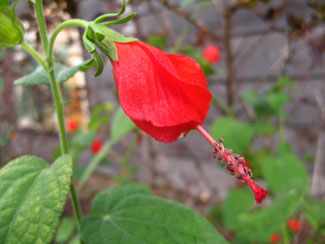Resource Library
Plant of the Week: Mallow, Turk's Cap
Turk’s Cap Mallow
Latin: Malvaviscus penduliflorus
Mallow, Turk's Cap -- Turk's Cap Mallow is a tender shrub that makes an interesting late season display in the garden. (Image courtesy Gerald Klingaman)
Turk’s cap mallow, also known as sleeping hibiscus or wax mallow, is a 6- to 8-foot-tall deciduous shrub in tropical Mexico where this cultigen originated. It is known only as a garden plant, having arisen as either a natural or man-made hybrid from the several wild species that occur in the tropical Americas. The plant has lanceolate leaves to 3 inches long and an inch or more wide with plants usually glabrous, or without hairs.
Its solitary, nodding flowers are produced late in the summer and in the fall in temperate regions in leaf axils at the ends of branches. The red flowers are a closed whorl of five petals, to 2 inches long that never open up. The identifying feature of the hibiscus family – the staminoid column – sticks out of the whorl of unopened petals a length equal to the length of the unopened petals. Through fruiting does occasionally occur in the tropics it is a rare event.
I feel like a stuck CD disk that keeps repeating the same lyrics as I bemoan the fact that taxonomists keep rearranging plant families. Usually they break them into smaller units, but with the mallow family they have used DNA tests to enlarge the family to include trees like lindens and bombax and a whole host of tropical species.
The logic behind all these reclassifications is that DNA can be used to identify the closest degrees of kinship regardless of physical appearance. Using this technique the cladists – the name given to this new breed of taxonomists – feel they can trace backwards on the family tree and identify where new branches emerge or, as in this case, rearrange the branches to reflect a more accurate degree of kinship. More information is always better than less, but it frustrates those of us that were perfectly happy with the old, cohesive, easily identified mallow family.
Turk’s cap mallow is a tender tropical shrub that survives above ground in only the mildest parts of Florida, Texas and California but it will overwinter further north so long as the ground does not freeze. I watched a plant for years that grew here in Fayetteville where it was planted right next to the house foundation. It finally disappeared, but I think a prolonged drought did it in, not frozen soil.
Most people treat this as a tropical plant and take in the old plant each season or start cuttings and overwinter it as young plants in a sunroom or greenhouse. It can be set into the ground in the spring where it grows to 3 feet tall by fall or it can be used in containers. Plants are best in full sun in any reasonably good soil so long as it is well watered during the summer months. Like many members of the mallow family white flies and aphids can be problematic, especially in the greenhouse.
By: Gerald Klingaman, retired
Retired Extension Horticulturist - Ornamentals
Extension News - November 1, 2013
